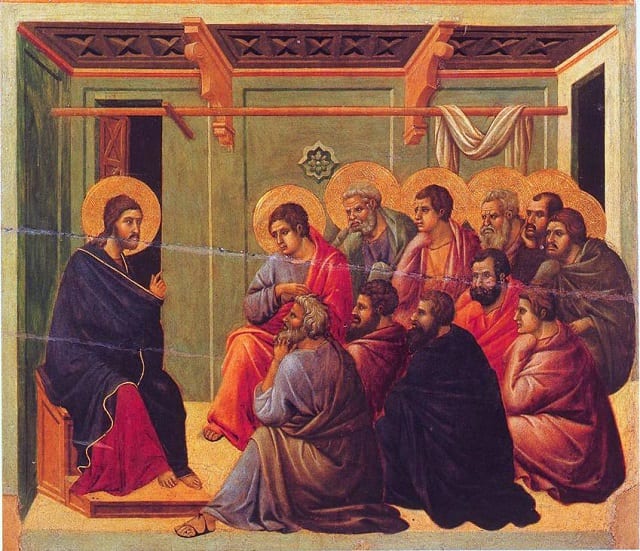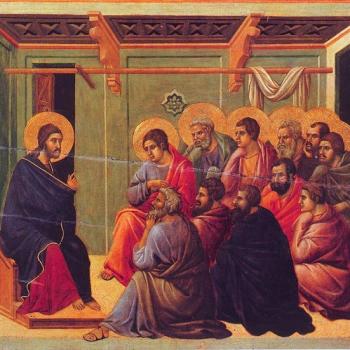And Does the Gospel of Mark Radically Differ from the Other Gospels in the “Family vs. Following Jesus” Aspect?

Atheist and anti-theist Bob Seidensticker, who was “raised Presbyterian”, runs the influential Cross Examined blog. He asked me there, on 8-11-18: “I’ve got 1000+ posts here attacking your worldview. You just going to let that stand? Or could you present a helpful new perspective that I’ve ignored on one or two of those posts?” He also made a general statement on 6-22-17: “Christians’ arguments are easy to refute . . . I’ve heard the good stuff, and it’s not very good.”
He added in the combox: “If I’ve misunderstood the Christian position or Christian arguments, point that out. Show me where I’ve mischaracterized them.” Such confusion would indeed be predictable, seeing that Bob himself admitted (2-13-16): “My study of the Bible has been haphazard, and I jump around based on whatever I’m researching at the moment.”
Bob (for the record) virtually begged and pleaded with me to dialogue with him in May 2018, via email. But by 10-3-18, following massive, childish name-calling attacks against me, encouraged by Bob on his blog (just prior to his banning me from it), his opinion was as follows: “Dave Armstrong . . . made it clear that a thoughtful intellectual conversation wasn’t his goal. . . . [I] have no interest in what he’s writing about.”
And on 10-25-18, utterly oblivious to the ludicrous irony of his making the statement, Bob wrote in a combox on his blog: “Someone who’s not a little bit driven to investigate cognitive dissonance will just stay a Christian, fat ‘n sassy and ignorant.” Again, Bob mocks some Christian in his combox on 10-27-18: “You can’t explain it to us, you can’t defend it, you can’t even defend it to yourself. Defend your position or shut up about it. It’s clear you have nothing.”
And again on the same day: “If you can’t answer the question, man up and say so.” And on 10-26-18: “you refuse to defend it, after being asked over and over again.” And again: “You’re the one playing games, equivocating, and being unable to answer the challenges.”
Bob’s cowardly hypocrisy knows no bounds. Again, on 6-30-19, he was chiding someone for something very much like he himself: “Spoken like a true weasel trying to run away from a previous argument. You know, you could just say, ‘Let me retract my previous statement of X’ or something like that.” Yeah, Bob could! He still hasn’t yet uttered one peep in reply to — now — 48 of my critiques of his atrocious reasoning.
Bible-Basher Bob’s words will be in blue. To find these posts, follow this link: “Seidensticker Folly #” or see all of them linked under his own section on my Atheism page.
*****
Bob writes in his article, “More Damning Bible Contradictions: #25 Was Jesus Crazy or God?” (12-12-19):
Jesus is crazy
Too little is made of a surprising passage from Mark. Jesus was preaching in Galilee, and then:
When [Jesus’s] family heard about [Jesus being nearby], they went to take charge of him, for they said, “He is out of his mind” (Mark 3:21).
The point of the story contrasts his actual family, who think he’s crazy, with his disciples, who have abandoned their professions to follow him. . . .
The interesting thing here is his family calling him crazy. How was that possible, when it was clear from other gospels that Jesus was divine?
Bob then correctly cites and interprets (stop the presses!) several passages which do indeed show that Jesus was God and that Mary knew He was (Mt 1:20-24; Lk 1:28-38; 2:8-19, 25-38). Of course, he thinks that this merely suggests contradiction between Matthew / Luke and Mark, but he has vastly misunderstood a passage in Mark, as I will proceed to demonstrate below. He again states correctly:
Not only are Mary and Joseph assured that their son is divine, but this isn’t a family secret. Word has spread far. The magi informed Herod’s court, and Herod killed infant boys for fear of a rival to the throne; the shepherds tell everyone they can about the angels’ message; Simeon publicly states in the Temple that Jesus is the Messiah; and the Temple teachers see his wisdom for themselves.
But then he presents his ludicrous thesis:
Making sense of the contradiction
Let’s return to Mark, where Jesus’s mother and brothers want to take charge of him because he’s crazy. Jesus can’t be both crazy and divine. But drop the requirement that these stories must harmonize, and the resolution is easy.
Matthew and Luke copy (sometimes verbatim) from Mark. In fact, 97 percent of Mark is copied by either Matthew or Luke or both. However, the nativity stories appear only in Matthew and Luke, and the “Jesus is crazy” story appears only in Mark. Mark threw the holy family under the bus to make the point that following Jesus is a higher calling than familial loyalty, but Matthew and Luke didn’t copy that story, perhaps because, as we’ve seen here, it conflicts with the clear evidence in the nativity stories that Jesus is different because he’s divine.
Mark and the other two synoptic gospels had different agendas.
It so happens that I have already refuted this lie and total misunderstanding at great length in my article, “Did the Blessed Virgin Mary Think Jesus Was Nuts?” (7-2-20). I need not reiterate the entire argument, since the link will suffice, but let me present a few highlights:
Mark 3:21-22 (RSV) And when his family heard it, they went out to seize him, for people were saying, “He is beside himself.” [22] And the scribes who came down from Jerusalem said, “He is possessed by Be-el’zebul, and by the prince of demons he casts out the demons.” (cf. Jn 10:20-21)
Note the italicized and bolded word. Other translations (including, unfortunately, KJV, NKJV, NIV, NASB) make it sound like Jesus’ family were agreeing and/or saying that Jesus’ was mad, but in fact the text is saying that “people” in general were doing so (just as the Pharisees did).
But if the text doesn’t refer to them, it can simply be construed as His family coming out to remove Him from the crowds, who were massively misunderstanding Him, accusing, and perhaps becoming violent (as at Nazareth, when they tried to throw Him over a cliff). Hence, there would be no necessary implication of His family’s (let alone Mary’s) disbelief in Him. They were concerned for His safety. Other translations convey the true sense of the passage (which is interpreted by 3:22 indicating that the “scribes” were saying Jesus was crazy):
NRSV When his family heard it, they went out to restrain him, for people were saying, “He has gone out of his mind.”
Good News / (TEV) When his family heard about it, they set out to take charge of him, because people were saying, “He’s gone mad!”
Moffatt . . . . . . for men were saying, “He is out of his mind.”
Phillips . . . for people were saying, “He must be mad!”
NEB . . . for people were saying that he was out of his mind. . . .
We know that there was some unbelief in the former [His extended family] (“For even his brothers did not believe in him”: John 7:5). But this doesn’t include Mary, nor can any passage be found that directly implies any disbelief in Mary about her Son and His status as God Incarnate and Messiah. She knew about that from the time of the Annunciation.
Nor is disbelief on the part of some of His relatives the same as thinking He was crazy; out of His mind.
This absolutely pulverizes Bob’s contention that Mark (with his supposed particular agenda, etc., etc.) was portraying Jesus’ family as against Him; thinking He had gone mad. It takes out one of his key premises: obtained from all of his skeptical reading about the Bible, from those who despise it and Christianity and Christians: which he parrots and uncritically regurgitates. If the foundation of his argument is wiped out, then the “house” of his silly argument collapses as well.
Bob makes another false statement within his overall fictional false narrative. I repeat it from above: “Mark threw the holy family under the bus to make the point that following Jesus is a higher calling than familial loyalty, . . .”
This larger point and theory of a supposed peculiarity in Mark is demonstrably untrue as well. All four Gospels have definite elements of “following Jesus as a priority over one’s own family.” The Gospel of John, as we saw in my quotation of my past paper, above, states, “For even his brothers did not believe in him” (7:5, RSV, as throughout this paper). Luke records Jesus saying, after His townsfolk in Nazareth rejected Him and tried to throw him off a steep cliff: “Truly, I say to you, no prophet is acceptable in his own country” (4:24). Matthew concurs: “A prophet is not without honor except in his own country and in his own house” (13:57; cf. Mk 6:4).
All the gospels agree in teaching this message about the conflict of loyalties between home / family and following Jesus / God as a called disciple. Mark is no different from the other three:
Matthew 4:18-22 As he walked by the Sea of Galilee, he saw two brothers, Simon who is called Peter and Andrew his brother, casting a net into the sea; for they were fishermen. [19] And he said to them, “Follow me, and I will make you fishers of men.” [20] Immediately they left their nets and followed him. [21] And going on from there he saw two other brothers, James the son of Zeb’edee and John his brother, in the boat with Zeb’edee their father, mending their nets, and he called them. [22] Immediately they left the boat and their father, and followed him.
Matthew 16:24-25 Then Jesus told his disciples, “If any man would come after me, let him deny himself and take up his cross and follow me. [25] For whoever would save his life will lose it, and whoever loses his life for my sake will find it.
Matthew 19:27-29 Then Peter said in reply, “Lo, we have left everything and followed you. What then shall we have?” [28] Jesus said to them, “Truly, I say to you, in the new world, when the Son of man shall sit on his glorious throne, you who have followed me will also sit on twelve thrones, judging the twelve tribes of Israel. [29] And every one who has left houses or brothers or sisters or father or mother or children or lands, for my name’s sake, will receive a hundredfold, and inherit eternal life.
Mark 1:16-20 And passing along by the Sea of Galilee, he saw Simon and Andrew the brother of Simon casting a net in the sea; for they were fishermen. [17] And Jesus said to them, “Follow me and I will make you become fishers of men.” [18] And immediately they left their nets and followed him. [19] And going on a little farther, he saw James the son of Zeb’edee and John his brother, who were in their boat mending the nets. [20] And immediately he called them; and they left their father Zeb’edee in the boat with the hired servants, and followed him.
Mark 8:34-35 And he called to him the multitude with his disciples, and said to them, “If any man would come after me, let him deny himself and take up his cross and follow me. [35] For whoever would save his life will lose it; and whoever loses his life for my sake and the gospel’s will save it.
Mark 10:28-30 Peter began to say to him, “Lo, we have left everything and followed you.” [29] Jesus said, “Truly, I say to you, there is no one who has left house or brothers or sisters or mother or father or children or lands, for my sake and for the gospel, [30] who will not receive a hundredfold now in this time, houses and brothers and sisters and mothers and children and lands, with persecutions, and in the age to come eternal life.
Luke 9:23-24 And he said to all, “If any man would come after me, let him deny himself and take up his cross daily and follow me. [24] For whoever would save his life will lose it; and whoever loses his life for my sake, he will save it.
Luke 18:28-30 And Peter said, “Lo, we have left our homes and followed you.” [29] And he said to them, “Truly, I say to you, there is no man who has left house or wife or brothers or parents or children, for the sake of the kingdom of God, [30] who will not receive manifold more in this time, and in the age to come eternal life.”
John 1:35-47 The next day again John was standing with two of his disciples; [36] and he looked at Jesus as he walked, and said, “Behold, the Lamb of God!” [37] The two disciples heard him say this, and they followed Jesus. [38] Jesus turned, and saw them following, and said to them, “What do you seek?” And they said to him, “Rabbi” (which means Teacher), “where are you staying?” [39] He said to them, “Come and see.” They came and saw where he was staying; and they stayed with him that day, for it was about the tenth hour. [40] One of the two who heard John speak, and followed him, was Andrew, Simon Peter’s brother. [41] He first found his brother Simon, and said to him, “We have found the Messiah” (which means Christ). [42] He brought him to Jesus. Jesus looked at him, and said, “So you are Simon the son of John? You shall be called Cephas” (which means Peter). [43] The next day Jesus decided to go to Galilee. And he found Philip and said to him, “Follow me.” [44] Now Philip was from Beth-sa’ida, the city of Andrew and Peter. [45] Philip found Nathan’a-el, and said to him, “We have found him of whom Moses in the law and also the prophets wrote, Jesus of Nazareth, the son of Joseph.” [46] Nathan’a-el said to him, “Can anything good come out of Nazareth?” Philip said to him, “Come and see.” [47] Jesus saw Nathan’a-el coming to him, and said of him, “Behold, an Israelite indeed, in whom is no guile!”
John 12:26 If any one serves me, he must follow me; and where I am, there shall my servant be also; if any one serves me, the Father will honor him.
So if Bob’s skeptical, irrational mythology of Mark supposedly emphasizing “following Jesus” as “a higher calling than familial loyalty” were true, why is it that Matthew and Luke (that he says copied most of Mark) — as well as John in a different way — contain the above passages about that very thing? There is simply no difference here.
Under Bob’s view, they should not. But since his view is false in the first place, they do. And when there is a proposed stark difference (the falsely alleged “his family — including His mother — thought He was nuts!” scenario), it’s seen to be utterly untrue in the first place.
So (shock and horror!) Bob is completely wrong yet again. Since he accepts no correction from a lowly Christian apologist like myself (now having completed 50 critiques / refutations of his errors), he never learns, and keeps repeating the same lies over and over; making a fool of himself and showing himself to be an intellectual coward.
Meanwhile, the Bible is again vindicated against his ceaseless attacks, as it always is, because it is inspired, infallible revelation from God.
***
Photo credit: Christ Taking Leave of the Apostles, by Duccio di Buoninsegna (1255-1319) [public domain / Wikimedia Commons]
***






























